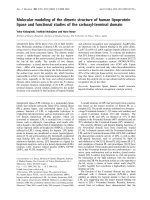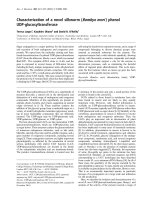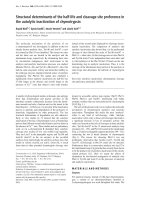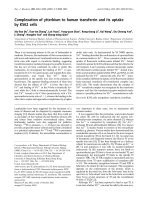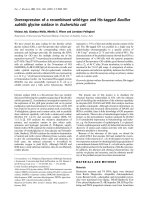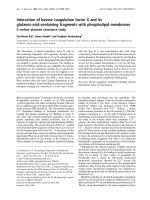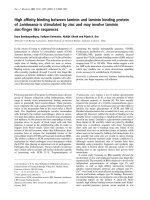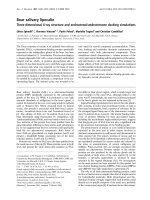Báo cáo Y học: Boar salivary lipocalin Three-dimensional X-ray structure and androstenol/androstenone docking simulations pot
Bạn đang xem bản rút gọn của tài liệu. Xem và tải ngay bản đầy đủ của tài liệu tại đây (545.06 KB, 8 trang )
Boar salivary lipocalin
Three-dimensional X-ray structure and androstenol/androstenone docking simulations
Silvia Spinelli
1,
*, Florence Vincent
1,
*, Paolo Pelosi
2
, Mariella Tegoni
1
and Christian Cambillau
1
1
Architecture et Fonction des Macromole
´
cules Biologiques, CNRS and Universite
´
s Aix-Marseille I & II, France;
2
Dipartimento di Chimica e Biotecnologie Agrarie, Universite
´
di Pisa, Italy
The X-ray structure of variant A of authentic boar salivary
lipocalin (SAL), a pheromone-binding protein specifically
expressed in the submaxillary glands of the boar, has been
solved and refined at 2.1 A
˚
resolution. The structure displays
a classical lipocalin fold with a nine-stranded sandwiched
b barrel and an a helix. A putative glycosylation site, at
position 53, has been found to carry a GlcNAc sugar residue.
In contrast with what was expected on the basis of mass
spectroscopy reports, the internal cavity was found to be
devoid of bound pheromonal compound (androstenone or
androstenol). Instead, a small electron density volume could
be satisfied by a glycerol molecule, a component of the cry-
oprotecting liquor. The internal cavity was revealed to be
very small for steroid compound accommodation. There-
fore, docking and molecular dynamics experiments were
performed with both pheromonal compounds. These
simulations clearly demonstrate a volume increase of the
cavity upon steroid binding and the adaptation of the amino-
acid side chains to the steroid molecules. This explains the
higher affinity of SAL for both steroid molecules compared
to other smaller molecules, although no specific interaction is
established with either compound.
Keywords: crystal structure; odorant binding protein; saliv-
ary lipocalin; steroid; pheromone.
Boar salivary lipocalin (SAL) is a pheromone-binding
protein (PBP) specifically expressed in the submaxillary
glands of the boar [1]. While it is produced in very high
amounts (hundreds of milligrams) in the boar’s gland, it
cannot be detected in the sow, even using sensitive methods
such as Western blot. When extracted from its natural
source, this protein is associated with both boar’s phero-
mones, 5a-androst-16-en-3-one and 5a-androst-16-en-3-ol
[2]. The affinity of SAL for 5a-androst-16-en-3-one has
been determined using fluorescence by competition with
1-aminoanthracene (AMA), and was found to be 0.4 l
M
[1].
Two isoforms of this protein have been purified from the
same individual, differing by three amino-acid substitutions
[1]. It was suggested that the two isoforms could specifically
bind the two pheromonal components. Both forms of
boar’s SAL are glycosilated at a single position, Asn53, and
present a disulphide bridge connecting two of the three
cysteines present, Cys68 and Cys160 [1].
Proteins very similar to SAL have also been purified from
the nasal mucosa of the pig [2]. These proteins occur in both
sexes and present the same amino-acid sequence as SAL,
but differ in their glycan region, which is much larger and
more complex in the nasal SAL, although linked to the
same Asn53. Interestingly, the same two isoforms produced
by the boar’s glands are also expressed in the nose [1].
Ligand-binding experiments have shown that the gland’s
SAL proteins, in native and recombinant forms, as well as
their nasal counterparts, bind a number of odorants, by far
the strongest ligand being one of the pheromone’s compo-
nent 5a-androst-16-en-3-one [1]. The similar binding beha-
viour of proteins differing for their glycosilated region,
including the recombinant unglycosilated protein, suggests
that the glycan part of SAL does not play a significant role
in the structural characteristics of the binding pocket.
The phenomenon of similar or even identical lipocalins
expressed in the nose and in other organs involved in
chemical communication is well known and documented in
other species [3,4]. The urinary proteins of mouse and rat
were the first to be identified as pheromone carriers [3]. They
are specifically produced by mature males and released in
the urine at concentrations of several milligrams per
millilitre. When excreted, they are strongly associated with
specific sex pheromones. Proteins similar to the urinary
proteins are also produced by the salivary glands and by
nasal glands of both sexes of the same species [3]. In the
hamster, a lipocalin (aphrodisin) is secreted in large
amounts in the vaginal discharge [5,6]. No investigation
on the nasal protein has been reported for this species, but
two odorant binding proteins (OBPs) of the mouse (OBP-Ia
and OBP-Ib) bear high similarities to aphrodisin [7].
The role of all these pheromone-binding proteins could
involve a function more complex than that of simple carriers
for hydrophobic molecules. Both physiological and bio-
chemical evidence strongly suggest that such proteins could
directly act on specific receptors of the nasal area, probably
of the vomeronasal organ [8]. It has been shown that urinary
Correspondence to M. Tegoni or C. Cambillau, Architecture et
Fonction des Macromole
´
cules Biologiques, UMR 6098, CNRS and
Universite
´
s Aix-Marseille I & II, 31 Chemin Joseph Aiguier,
13402 Marseille Cedex 20, France.
Fax: + 33 491 16 45 36, Tel.: + 33 491 16 45 01,
E-mail: or
Abbreviations: AMA, 1-aminoanthracene; OBP, odorant binding
protein; SAL, boar salivary lipocalin; Glc-Nac,
N-acetylglucosamine; androstenol, 5a-androst-16-en-3-ol;
androstenone, 5a-androst-16-en-3-one.
*Note: these authors contributed equally to the work.
(Received 7 November 2001, accepted 22 March 2002)
Eur. J. Biochem. 269, 2449–2456 (2002) Ó FEBS 2002 doi:10.1046/j.1432-1033.2002.02901.x
proteins can accelerate the onset of puberty in young
immature female mice, when applied to the nasal cavity [9].
It has also been reported that the same proteins are able to
activate a G protein of the vomeronasal system [10].
Therefore, if a specific interaction occurs between phero-
mone-binding lipocalins and receptors of the vomeronasal
organ, it is important to fully understand the structure of
these soluble proteins and try to identify regions where
interaction with membrane-bound receptors could occur.
In this paper, we report the structure of the variant A of
native boar salivary lipocalin, solved and refined at 2.1 A
˚
resolution. Due to the lack of naturally occurring phero-
mone in the structure, we have performed dynamic docking
simulations with the two specific pheromones of SAL. The
results indicate a conformational change of the side-chains
of the residues belonging to the internal cavity, which adapt
to the steroid molecules.
MATERIALS AND METHODS
Crystallization conditions and data collection
The protein purification and characterization has been
previously described [2]. Crystals of SAL were obtained with
hanging drops over a reservoir containing 1.95
M
ammo-
nium sulphate, 0.1
M
sodium citrate pH 5.5 and 0.2
M
potassium/sodium tartrate. The drops contained 3 lLof
protein solution at 3 mgÆmL
)1
,2.4lL of reservoir solution
and 0.6 lL of cadmium chloride 10 m
M
.Thecrystalsizewas
further improved by macro-seeding. The crystals belong to
the tetragonal space group P4
1
2
1
2 with cell parameters
a ¼ b ¼ 69.87 A
˚
, c ¼ 71.42 A
˚
. With one molecule per
asymmetric unit, the V
m
has a value of 2.18 A
˚
3
ÆDa
)1
.
A first data set has been collected in the lab at 2.7 A
˚
resolution from a flash-frozen (100 K) crystal, soaked in
12.5% (v/v) glycerol as cryoprotectant, with a MAR-
research 345-image plate placed on a Rigaku RU200
rotating anode. The diffraction data were processed with
DENZO
[11] and
SCALA
[12]; and data reduction was
performed by
TRUNCATE
[12] (Table 1).
Structure determination and refinement
The structure was solved by molecular replacement, using
AMoRe [13] with the horse allergen lipocalin, which has
44% homology with SAL, as a search model (PDB 1EW3).
A clear solution was obtained with a correlation coefficient
of 0.416 and a R value of 47.6% at 3.5 A
˚
. Cartesian
refinement cycles were carried out with
CNS
[14] using bulk
solvent correction and simulated annealing. At each stage of
the refinement, the model was examined on a display and
manually refitted into the sigmaA-weighted electron density
maps [15] with the program
TURBO
-
FRODO
[16]. A data set
was subsequently collected at 2.1 A
˚
resolution on the ID14-
EH2 synchrotron station (ESRF, Grenoble), and refine-
ment was extended to this resolution. The final R
work
and
R
free
were, respectively, 25.4 and 28.2% (Table 1). No
density could be observed for the first seven N-terminal
residues, or for the 10 remaining saccharidic residues of the
complex glycan. These two disordered parts (14% of total
mass), together with the high B-factors, explain the high
R
free
obtained after refinement converged. The stereochem-
istry was analysed with
PROCHECK
[17] which assigned
87.6% residues in the most favourable region and 12.4%
residues in the additional allowed region. The coordinates
have been deposited in the Protein Data Bank at RCSB
( under entry 1 G6.
Docking experiment with androstenol and androstenone
The previously identified natural ligands androstenol and
androstenone have been built with the program
ACD
/
CHEM-
SKETCH
[18]. The parameter and topology files for
CNS
[14]
were obtained using the automated procedure of
XDICT
[19].
The ligands were manually introduced in the cavity in a
position suitable to get a minimum number of clashes using
TURBO
-
FRODO
[16] running on a
SGI OCTANE
. The automated
docking performed with
CNS
started from this position and
involved positional minimization of the ligand and the
protein. During the initial minimization steps, the Ca atoms
were constrained to their initial positions and a harmonic
restraint was applied on the side chain atoms. The ligand
was left without any restraint. In subsequent steps, the
constraints were removed and the restraints decreased.
RESULTS AND DISCUSSION
The overall structure of boar SAL
SAL belongs to the lipocalin family as its sequence has
identity ranging between 64 and 57% in pair-wise compar-
isons with other members of the lipocalin family of known
three-dimensional structure [1] (Fig. 1). SAL is a monomer,
as are horse allergen [20], MUP [21], a2micro-globulin [21]
and aphrodisin [22], but not bovine OBP [23]. It contains
165 residues on which residues 8–165 could be identified in
the electron density maps. SAL is formed of the classical
Table 1. Final statistics of SAL structure. Data collection and refine-
ment statistics.
Data collection
Resolution limits (A
˚
) 28.8–2.1
Completeness (I/r(I) > I) 99.6 (99.6)
I/r(I) > I (all/last shell) 7.3 (2.4)
Redundancy 3.9 (4.0)
R
sym
(all/last shell)
a
5.6 (29.5)
Refinement
Resolution limits 15–2.13
Total number reflections 10 107
Nb of protein atom (+ odor) 1284
Final R
factor
/R
free
c
25.2/28.3
Average B factors molecules A and B
Side chain 42.5
Main chain 40.2
Solvent 53.8
Ligands (Glycerol + NAG + Cd
2+
) 50.6
Nb of water molecules 112
Rms deviation from ideal value
Bonds(A
˚
)/angles 0.011/1.4
Dihedral angles 27.0
Improper angles 1.11
a
R
sym
¼ S|I
i
)<I>|/S I
i
, where I
i
is the intensity of an indi-
vidual reflection and <I> is the mean intensity of that reflection.
b
Number of reflections: 1063.
2450 S. Spinelli et al. (Eur. J. Biochem. 269) Ó FEBS 2002
nine-stranded b barrel (residues 19–125, 151–153), a hinge
region (144–149) and a a helical domain (130–143) (Fig. 2).
Two conserved cysteines (Cys68 and Cys160) form the
conserved disulphide bridge between the C-terminal tail and
the b barrel (Fig. 2). A Glc-NAc moiety is observed at one
out of the three glycosylation consensus sequences detected
in the natural protein (see below; Fig. 1). A strong Fourier
difference density map was identified at the interface
between SAL and a symmetry related molecule. This
density could be satisfied with a cadmium ion (Cd
2+
), a
cation present in the crystallization medium.
Two variants of SAL have been identified [1]. The
crystallized protein belongs to variant A, as confirmed by
the electron density in accord with the presence of Val45,
Ile48 and Ala73, instead of Ala45, Val48 and Val73 present
in variant B.
Glycosylation site
Three consensus glycosylation sites are present in the
sequence of SAL at residues Asn53, Asn38 and Asn99
(Fig. 1), but post-translational modifications studies have
shown that only one oligosaccharide complex is linked to
Asn53 [1]. The crystal structure confirms this assignation
because an electron density for the first Glc-NAc residue is
observed linked to Asn53. One of the two glycosylation sites
identified in horse allergen [24] is identical to that of SAL
and takes the same orientation (Fig. 3). Two putative
glycosylation sites have been identified in the native hamster
aphrodisin, at Asn41 and Asn69 [25] (Fig. 1). The structure
of the recombinant protein indeed did not comprise
N-linked saccharides, but Glc-NAc residues have been
modelled, linked to each Asn22. If we superimpose the
three-dimensional structures of SAL with aphrodisin,
Asn53 of SAL corresponds to Asn41 in aphrodisin. In the
case of aphrodisin, Asn41 is located in a loop, which
contains a disulphide bridge characteristic of its PBP
subclass. However, the direction of Asn and its bound
sugar is different relative to SAL (Fig. 3).
The internal cavity
The main cavity, delineated by the b barrel, is not shielded
from the solvent because a small opening formed by the ring
Fig. 1. Amino-acid sequence of SAL aligned with those of other mammalian lipocalins. Horse allergen and PBPs such as a2l-globulin, MUP1 and
hamster aphrodisin. The potential glycosylation sites of SAL and aphrodisin are identified by blue filled circles, the red circle marks where a sugar is
observed in the electron density map.
Fig. 2. Stereoview of SAL X-ray structure in
ribbon representation. The helix is in red,
strands are blue and turns or coil are yellow.
The GlcNAc residue bound to Asn53 is in
white ball-and-stick, and the serendipitous
ligand, glycerol, in green ball-and-stick.
Ó FEBS 2002 Boar salivary lipocalin structure (Eur. J. Biochem. 269) 2451
of side-chains of residues Phe60, Ala73, Val85, Tyr87,
Met41, is observed at one extremity of the barrel
(not shown). As the protein used in the crystallization
is the natural one, we expected to find an electron
density accounting for the natural ligands as identified by
mass spectroscopy, namely 5a-androst-16-ene-3-one or
5a-androst-16-ene-3a-ol, both known as sex pheromones
for the pig [2]. Surprisingly, this cavity is devoid of such
ligands, but a smaller electron density volume was identified,
compatible with the size and the shape of a glycerol
molecule, probably introduced during cryoprotectant soak-
ing (Fig. 4). However, all experiments designed to obtain
data from crystals containing 5a-androst-16-ene-3-one or
5a-androst-16-ene-3a-ol failed.
The wall of the cavity is mostly formed by hydrophobic
residues: Val45, Phe58, Ala73, Val85, Phe93, Leu106 and
Leu108. Three weakly polar residues, Tyr87, Tyr123 and
Cys75, complete the cavity wall (Table 2). As in the case of
horse allergen, Glu121 protrudes inside the cavity, making a
hydrogen bond with an alcohol function of glycerol (Fig. 4).
In most lipocalins, the b barrel contains one or several
internal cavities. In SAL, besides the main cavity, four
smaller ones are also observed (Fig. 5A). The volume of the
main cavity, as calculated with the program
GRASP
[26], is
315 A
˚
3
. The four other cavities have volumes of 40, 33, 33
and 32 A
˚
3
. Two of the smaller cavities are close to the main
one, separated only by side chains, while two others are at
the periphery of the protein (Fig. 5A). Unexpectedly, the
volume of the main cavity is one of the smallest among
lipocalins of known three-dimensional structures. The
cavity of MUP has a volume of 510 A
˚
3
(Fig. 5C), porcine
OBP of 500 A
˚
3
, bovine OBP of 441 A
˚
3
,hamster
aphrodisin 350 A
˚
3
, and horse allergen (Fig. 5B), has the
smallest, 273 A
˚
3
. The small size of the main cavity in SAL
may be due to the presence of few other cavities. Indeed, as
described below, the size of the cavity of the SAL model
complexed with the two steroids reaches a value 500 A
˚
3
.
The increase in volume is due in part to the fusion of
the main cavity with the two adjacent minor cavities,
resulting of amino-acid side-chains conformational changes
(Fig. 6).
Residues 45 and 73 are located in the cavity and are
involved in conformational changes. Interestingly, these
residues are Val and Ala, respectively, in isoform A of SAL,
the structure of which is described here, and are replaced in
isoform B by Ala and Val, respectively. Replacement of
residues 43 and 75 with those of isoform B in the SAL X-ray
model did not produce significant modifications of the
cavity upon complexation (see below).
Docking experiments
As mass spectroscopy showed that androstenone and
androstenol were present together in the same sample of
SAL, we decided to perform docking modelling experiments
with either of them. We have chosen a simple and safe
procedure using minimal constraints and restraints, with the
Fig. 3. Ribbon view of the lipocalin scaffold and of the three glycosylated
loops and GlucNAC in SAL (white), horse allergen (blue) and aphrodisin
(violet).
Fig. 4. Stereo view of the electron density map of bound glycerol in the SAL combining site.
2452 S. Spinelli et al. (Eur. J. Biochem. 269) Ó FEBS 2002
aim of testing the flexibility of the side-chain residues in the
closed cavity upon steroid docking. This procedure cannot
be compared to a full molecular dynamics study, but should
yield the most striking features of the docking experiment.
The structures of the ligands were generated and minim-
ized with the program
ACD
/
CHEMSKETCH
[18]. The resulting
conformations are different as expected from their chemical
difference, as the A ring bears a hydroxyl in androstenol and
a keto function in androstenone. The conformation of rings
D and C is almost superimposed in the two ligands, but they
diverge more closer to ring A, which bears the different
functional group.
Either of the two steroid molecules has a volume of
240 A
˚
3
, slightly smaller than that of the cavity (315 A
˚
3
)and
an elongated shape, limiting the number of starting
orientations to two positions. The first molecule has a polar
function pointing to the opening of the cavity, towards the
solvent (position ÔoutÕ). The second, at 180° to the first, has
the polar function directed to the centre of the protein
(position ÔinÕ) (Fig. 7A,B).
Table 2. List of the residues forming the wall of several lipocalins. SAL (this work), porcine OBP [27], bovine OBP [28] (F. Vincent, S. Spinelli,
R. Ramori, S. Grolli, M. Tegoni, C. Cambillau, unpublished results), horse allergen [30], mouse MUP [21] and hamster aphrodisin [22]. The
residues interacting with androstenol (#) and androstenone (§) are identified by crosses, the letters i and o identify the positions ÔinÕ and ÔoutÕ,
respectively. The residues in bold are strictly homologous in the six lipocalins, those in italics are the residues of SAL conserved in other lipocalins.
Boar
SAL
Boar-SAL with
androstenol (#) /androstenone (§)
p-OBP b-OBP
Horse
allergen
Mouse
MUP
Hamster
aphrodisin
#i #o §i §o
Leu27 Ile21 Ile22 Leu42 Leu28 Ile15
Met41 ··Phe35 Phe36 Met56 Phe42 Leu29
Val43 ··Val37 Thr38 Val58 Leu44 Phe31
Val45 ···Met39 Phe40 Val60 Leu46 Phe33
Phe58 ····Leu53 Phe54 Ala73 Leu58 Ile47
Phe60 ·· ·Phe55 Phe56 Tyr75 Phe60 Phe49
Ala73 ··Leu68 Val69 Met88 Met73 Val62
Cys75 ···Gly70 Ala71 Phe90 Ala75 Gly64
Val85 ···Val80 Ala81 Leu101 Val86 Thr74
Tyr87 ····Tyr82 Tyr83 Tyr103 Tyr88 Phe76
Asn91 ··Asn86 Asn87 Asn107 Asn92 Asn80
Phe93 ····Phe88 Phe89 Phe109 Phe94 Phe82
Leu106 ····Ile100 Ala101 Leu122 Ala107 Phe94
Leu108 ····Asn102 Asn103 Leu124 Leu109 Asn96
Leu119 · Met114 Leu115 Leu135 Leu120 Met108
Glu121 ····Gly116 Gly117 Glu137 Gly122 Val110
Tyr123 ···Leu118 Phe119 Tyr139 Tyr124 Ala112
Fig. 5. GRASP representation of the cavities
observed in three lipocalins. (A) SAL (B) horse
allergen and (C) MUP.
Fig. 6. GRASP representation of the cavities
observedinSAL.(A) Native SAL in the X-ray
structure (variant ÔAÕ) (B) in model complex
with androstenol in position ÔinÕ,and(C)in
position ÔoutÕ. The cavities for variant ÔBÕ are
undistinguishable from those for variant A.
The cavities of the complexes with androste-
none are undistinguishable from those with
androstenol.
Ó FEBS 2002 Boar salivary lipocalin structure (Eur. J. Biochem. 269) 2453
In the four starting positions, ÔinÕ and ÔoutÕ for andros-
tenone and androstenol, we have observed clashes between
the steroid and the protein that could not be eliminated
manually. Therefore, we performed a careful and conser-
vative energy minimization with
CNS
in order to make it
possible for the steroid and the internal side-chains to reach
an optimum position. We performed nine cycles of energy
minimization refinement in which the harmonic restrained
forces were progressively reduced. The structures obtained
when convergence was achieved were taken as the final
results of the modelling. Relative to the initial structures, we
observed in these models the displacement of several side-
chains covering the wall of the cavity. Indeed, the initial ÔinÕ
or ÔoutÕ orientation of the ligand was kept at the end of the
minimization and no changes were observed in the confor-
mation of the ligand. After docking, irrespectively to the
orientation ÔinÕ or ÔoutÕ, two of the four small cavities
collapsed with the main one to form a larger binding pocket
(Figs 6B,C). The size of the cavity accommodating the
ligand reached 560 A
˚
3
, although three peripheral cavities of
40, 60 and 20 A
˚
3
were still present.
In the final models, the molecules of androstenone and
androstenol adopt the two opposite orientations relative to
the b barrel (Figs 7A,B). The interactions between the
residues covering the wall of the cavity and the two
positions of the two steroids are hydrophobic and very
similar in the ÔinÕ or ÔoutÕ positions (Table 2). The shape
complementarity between the cavity and the ligands is good
but not optimal, as extra unfilled space remains (Fig. 7C,D).
In Fig. 7C, the opening of the cavity is clearly visible within
the sliced portion of the surface. Indeed, side-chain rotations
aresufficienttomakeitpossibleforthesteroidstogoinor
out through this opening.
As a polar moiety is present in both steroids, it was
tempting to speculate on the possible interaction of this
group with a polar residue in the cavity (Glu121 or Tyr123).
Unfortunately, and in contrast to the glycerol binding, no
interaction appears to occur between the polar function of
either ligand oriented ÔinÕ and a polar residue in the cavity.
Thus, the presence of the polar residues (Glu121 or Tyr123)
inside the otherwise apolar cavity is difficult to justify on the
basis of androstenol/one binding. For the ÔoutÕ positions,
Fig. 7. Views of the model of the complex of androstenol bound in SAL, with in (A) and (C) the ligand in position ÔinÕ, with the OH pointing inside the
cavity and, in (B) and (D) the ligand in position ÔoutÕ, with the OH pointing towards the bulk solvent. Besides the polar group, the positions of
androstenone (not shown) are undistinguishable from those of androstenol. In (A) and (B): view of the lipocalin scaffold and the bound ligand. In
(A) and (B) the rings of the ligand are named A to D from the polar function. In the insert, the chemical structure of the steroids is represented. In
(C) and (D) the molecular surface is represented, slabbed at the level of the ligand containing cavity. The blue arrows in (C) and (D) indicates the
cavity opening.
2454 S. Spinelli et al. (Eur. J. Biochem. 269) Ó FEBS 2002
the polar functions point in the direction of the bulk
solvent.
As mentioned above, the conformation of residues 45 and
73 changes upon docking in isoform A (Val45, Ala73) but
not in isoform B (Ala45, Val73). Besides this difference, the
increase of the volume of the cavity upon ligand biding is
very similar in the two isoforms, as well as the interactions
between the side chains of the three differing residues (45, 73
and48)andthetwosteroids.
The SAL residues forming the wall of the cavity are listed
in Table 2 and compared with those observed in other
lipocalins, OBPs and PBPs, including pig and bovine OBP,
horse allergen, MUP and hamster aphrodisin. Among the
residues homologous in the six structures (in blue and red),
four are strictly conserved (Phe60, Tyr87, Asn91 and Phe93)
and they all interact with the steroids; three of them are
aromatic and contribute at shaping the cavity. As reported
previously, the volume cavities of horse allergen and MUP
are very similar [20], and they are the most similar to the
cavity of SAL; the cavities of OBPs come next in similarity,
followed by aphrodisin.
No specificity was reported for pOBP towards several
classes of odours [27] and the same seems to be true for
bOBP (F. Vincent, S. Spinelli, R. Ramori, S. Grolli,
M. Tegoni, C. Cambillau, unpublished results), although
a naturally bound ligand was reported to be copurified and
visible in the structure [28]. In contrast, rat OBPs 1–3 exhibit
some preference, if not specificity, for certain classes of
chemical compounds [29].
SAL affinity for 1-amino-anthracene, for androstenone,
and for a group of odors such as 3,7-dimethyl-1-octanol,
2-phenyl ethanol, 2-isobutyl-3-methoxypyrazine has been
assayed by fluorescence [1]. The affinity of SAL was by far
higher for the steroids than for the other compounds [1]. Our
results clearly explain this observation on a structural basis.
The cavity of SAL can fit rather closely the two steroids,
whereas the other compounds, being smaller, will not
establish as many favourable van der Waals interactions.
In previous reports, such as that with pOBP, it was observed
no or little side-chain movement upon odor binding. Indeed,
the pOBP cavity is larger, and the odors are smaller than
those of SAL. This indicates that SAL, although being able
to bind a certain variety of small molecules, is able to perform
side-chain conformational changes in order to optimize its
cavity to accommodate the naturally occurring ligands.
CONCLUDING REMARKS
Boar salivary lipocalin displays a close structural relation
with other lipocalins such as horse allergen, a2l-globulin
and MUP. It contains a main cavity open to the solvent and
several minor ones. Likely due to this fragmentation of the
inner volume, the main cavity is smaller than those of other
lipocalins. The fragmentation itself is due to side-chain
orientations of the internal residues differing slightly from
those of other structures. After docking experiments with
the natural ligands, the main cavity and two smaller cavities
fuse, giving rise to an internal cavity (560 A
˚
3
) as large as that
of other OBPs. The docking experiments explored two sets
of starting positions for androstenone and androstenol. The
results indicate a close similarity of the respective solutions
for both steroids, both with good complementarity with the
cavity wall surface.
ACKNOWLEDGEMENTS
This study was supported in part by a ÔFondation pour la Recherche
Me
´
dicaleÕ (FRM) grant and by the EU BIOTECH Structural Biology
project OPTIM (BIO4-98-0420 OPTIM).
REFERENCES
1. Loebel, D., Scaloni, A., Paolini, S., Fini, C., Ferrara, L., Breer, H.
& Pelosi, P. (2000) Cloning, post-translational modifications,
heterologous expression and ligand-binding of boar salivary
lipocalin. Biochem. J. 350 Part 2, 369–379.
2. Marchese, S., Pes, D., Scaloni, A., Carbone, V. & Pelosi, P. (1998)
Lipocalins of boar salivary glands binding odours and phero-
mones. Eur. J. Biochem. 252, 563–568.
3. Bacchini, A., Gaetani, E. & Cavaggioni, A. (1992) Pheromone
binding proteins of the mouse, Mus musculus. Experientia 48, 419–
421.
4. Magert, H.J., Hadrys, T., Cieslak, A., Groger, A., Feller, S. &
Forssmann, W.G. (1995) cDNA sequence and expression pattern
of the putative pheromone carrier aphrodisin. Proc. Natl Acad.
Sci. USA 92, 2091–2095.
5. Singer, A.G. (1991) A chemistry of mammalian pheromones.
J Steroid Biochem. Mol. Biol. 39, 627–632.
6. Singer, A.G. (1990) Aphrodisin: pheromone or tranducer. Chem.
Senses. 15, 199–203.
7. Pes, D. & Pelosi, P. (1995) Odorant-binding proteins of the mouse.
Comp.Biochem.Physiol.BBiochem.MolBiol.112, 471–479.
8. Brennan, P.A. (2001) The vomeronasal system. Cell. Mol. Life Sci.
58, 546–555.
9. Mucignat-Caretta, C., Caretta, A. & Cavaggioni, A. (1995)
Acceleration of puberty onset in female mice by male urinary
proteins. J. Physiol. 486, 517–522.
10. Krieger, J., Schmitt, A., Lobel, D., Gudermann, T., Schultz, G.,
Breer, H. & Boekhoff, I. (1999) Selective activation of G protein
subtypes in the vomeronasal organ upon stimulation with urine-
derived compounds. J. Biol. Chem. 274, 4655–4662.
11. Otwinovski, Z. (1993) DENZO: oscillation data and reducing
program. In Data collection and processing (Sawyer, L., Isaacs,
N.W. & Bailey, S., eds), DLSCI/R34 Daresbury Laboratory,
Warrington, UK.
12. CCP4 & 4, C.C.P.N. (1994) The CCP4 suite: programs for crys-
tallography. Acta Crystallogr. D 50, 760–766.
13. Navaza, J. (1994) AMoRe: an automated package for molecular
replacement. Acta Crystallogr. A 50, 157–163.
14. Brunger, A.T., Adams, P.D., Clore, G.M., Delano, W.L., Gros,
P., Grosse-Kunstleve, R.W., Jiang, J.S., Kuszewski, J., Nilges, M.,
Pannu, N.S., Read, R.J., Rice, L.M., Simonson, T. & Warren, G.
(1997–99) Crystallographic and NMR System (CNS),
CNSSOLVE. Yale Universty Press, New Heaven, CT.
15. Read, R.J. (1986) Improving Fourier coefficients for maps using
phases from partial structures with errors. Acta Crystallog. A 42,
140–149.
16. Roussel, A. & Cambillau, C. (1991) The TURBO-FRODO
graphics package. Silicon graphics Geometry Partners Directory,
Mountain View, USA.
17. Laskowski, R., MacArthur, M., Moss, D. & Thornton, J. (1993)
PROCHECK: a program to check the stereochemical quality of
protein structures. J. Appl. Crystallogr. 26, 91–97.
18. Spessard, G.O. (1998) ACD labs/logP dB 3.5 and Chemsketch 3.5.
J. Chem. Inf. Comput. Sci. 38, 218–230.
19. Kleywegt, G.J. & Jones, T.A. (1998) Databases in protein crys-
tallography. Acta Crystallogr. D 54, 1119–1131 (CCP4
Proceedings).
20. Lascombe, M.B., Gregoire, C., Poncet, P., Tavares, G.A.,
Rosinski-Chupin, I., Rabillon, J., Goubran-Botros, H., Mazie,
J.C., David, B. & Alzari, P.M. (2000) Crystal structure of the
Ó FEBS 2002 Boar salivary lipocalin structure (Eur. J. Biochem. 269) 2455
allergen Equ c 1. A dimeric lipocalin with restricted IgE-reactive
epitopes. J. Biol. Chem. 275, 21572–21577.
21. Bocskei, Z., Groom, C.R., Flower, D.R., Wright, C.E., Phillips,
S.E., Cavaggioni, A., Findlay, J.B. & North, A.C. (1992) Phero-
mone binding to two rodent urinary proteins revealed by X-ray
crystallography. Nature 360, 186–188.
22. Vincent, F., Lobel, D., Brown, K., Spinelli, S., Grote, P., Breer,
H., Cambillau, C. & Tegoni, M. (2001) Crystal structure of aph-
rodisin, a sex pheromone from female hamster. J. Mol. Biol. 305,
459–469.
23. Tegoni, M., Ramoni, R., Bignetti, E., Spinelli, S. & Cambillau, C.
(1996) Domain swapping creates a third putative combining site in
bovine odorant binding protein dimer. Nat.Struct. Biol. 3, 863–867.
24. Gregoire, C., Rosinski-Chupin, I., Rabillon, J., Alzari, P.M.,
David, B. & Dandeu, J.P. (1996) cDNA cloning and sequencing
reveal the major horse allergen Equ c 1 to be a glycoprotein member
of the lipocalin superfamily. J. Biol. Chem. 271, 32951–32959.
25. Henzel, W.J., Rodriguez, H., Singer, A.G., Stults, J.T., Macrides,
F., Agosta, W.C. & Niall, H. (1988) The primary structure of
aphrodisin. J. Biol. Chem. 263, 16682–16687.
26. Nicholls, A., Sharp, K. & Honig, B. (1991) Protein folding and
association: insights from the interfacial and thermodynamic
properties of hydrocarbons. Proteins: Struct. Funct. Genet. 11,
281–296.
27. Vincent, F., Spinelli, S., Ramoni, R., Grolli, S., Pelosi, P.,
Cambillau, C. & Tegoni, M. (2000) Complexes of porcine odorant
binding protein with odorant molecules belonging to different
chemical classes. J. Mol. Biol. 300, 127–139.
28. Ramoni, R., Vincent, F., Grolli, S., Conti, V., Malosse, C., Boyer,
F.D., Nagnan-Le Meillour, P., Spinelli, S., Cambillau, C. &
Tegoni, M. (2000) The insect attractant, 1-octen-3-ol is the natural
ligand of bovine odorant binding protein. JBiolChem. 276, 7150–
7155.
29. Lobel, D., Strotmann, J., Jacob, M. & Breer, H. (2001) Identifi-
cation of a third rat odorant-binding protein (obp3). Chem Senses.
26, 673–680.
30. Gregoire, C., Tavares, G.A., Lorenzo, H.K., Dandeu, J.P., David,
B. & Alzari, P.M. (1999) Crystallization and preliminary crystal-
lographic analysis of the major horse allergen Equ c 1. Acta
Crystallogr. D 55, 880–882.
2456 S. Spinelli et al. (Eur. J. Biochem. 269) Ó FEBS 2002

